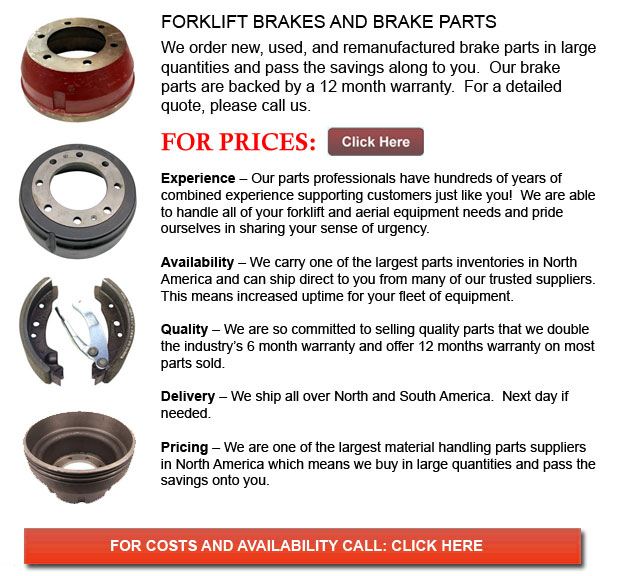
Brake for Forklift - A brake drum is in which the friction is provided by the brake shoes or brake pads. The pads or shoes press up against the rotating brake drum. There are several different brake drums types together with particular specific differences. A "break drum" will normally refer to whenever either pads or shoes press onto the interior outside of the drum. A "clasp brake" is the term used so as to describe if shoes press next to the exterior of the drum. Another type of brake, referred to as a "band brake" utilizes a flexible belt or band to wrap round the exterior of the drum. Whenever the drum is pinched in between two shoes, it can be referred to as a "pinch brake drum." Like a conventional disc brake, these kinds of brakes are rather rare.
Early brake drums, before 1955, needed to be consistently adjusted in order to compensate for wear of the shoe and drum. "Low pedal" could cause the needed adjustments are not done sufficiently. The motor vehicle can become dangerous and the brakes could become ineffective if low pedal is combined with brake fade.
There are a variety of Self Adjusting Brake Systems available, and they can be categorized within two major kinds, RAD and RAI. RAI systems have built-in equipments that prevent the systems to be able to recover when the brake is overheating. The most recognized RAI makers are AP, Bendix, Lucas, and Bosch. The most well-known RAD systems consist of AP, Bendix, Ford recovery systems and Volkswagen, VAG.
The self adjusting brake would normally just engage whenever the lift truck is reversing into a stop. This method of stopping is acceptable for use where all wheels utilize brake drums. Disc brakes are used on the front wheels of vehicles these days. By working only in reverse it is less likely that the brakes will be adjusted while hot and the brake drums are expanded. If adapted while hot, "dragging brakes" could happen, which raises fuel intake and accelerates wear. A ratchet device that becomes engaged as the hand brake is set is one more way the self repositioning brakes may function. This means is only suitable in functions where rear brake drums are utilized. If the parking or emergency brake actuator lever exceeds a specific amount of travel, the ratchet advances an adjuster screw and the brake shoes move toward the drum.
There is a manual adjustment knob located at the base of the drum. It is usually adjusted via a hole on the other side of the wheel and this requires going beneath the lift truck with a flathead screwdriver. It is of utmost significance to be able to move the click wheel properly and tweak each and every wheel evenly. If unequal adjustment happens, the vehicle could pull to one side during heavy braking. The most effective way so as to ensure this tiresome job is done safely is to either lift each wheel off the ground and hand spin it while measuring how much force it takes and feeling if the shoes are dragging, or give every\each and every one the same amount of clicks utilizing the hand and then do a road test.
![]() Click to Download the pdf
Click to Download the pdf
Forklift Parts







Lift Parts Express
TOLL FREE: 1-888-695-7994
LOCAL: (626) 416-3005
1004 W Covina Pkwy #472
West Covina, California
forkliftpartswestcovina.com
Email Us
About Us



